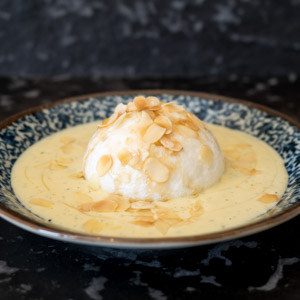Ile fottante (Snow eggs)

One of my dad’s favorite desserts. Another recipe quick enough to make, and adaptable to envy!
HISTORY. The first mentions are found in cookbooks or in the dictionary of the French Academy around 1800.
A DIFFERENCE WITH THE FLOATING ISLAND? Yes and no. According to Escoffier, a reference in cuisine, the floating island is a dessert (a jelly or a cake …) surrounded by a thin custard sauce. The only point in common with our recipe is the custard. Nevertheless it would seems that today the recipe is much the same unlike cooking meringues, which is done for floating islands in a bain-marie in the oven, while poached for the snow eggs.
INGREDIENTS – Custard Sauce – 4-6 people
- 400gr of milk
- 4 egg yolks
- 30gr of caster sugar
- 1 vanilla pod
NOTE. This recipe is not very sweet, but you can adjust the sugar portion according to your taste. Likewise, I have indicated caster sugar, but you can choose the sugar you like: honey, brown sugar, agave syrup …
Some recipes indicate proportions up to half-cream, half-milk. Take the test and choose accordingly to your preference!
NOTE 2. I have put a vanilla pod for a “classic” version, but you can flavour your custard with orange blossom water, citrus zest, coffee, chocolate, rum or a fruit alcohol…
RECIPE – Custard Sauce
- Mix the egg yolks and the sugar. No need to whiten them or even make them foamy, we even try to avoid it.
- Put the vanilla bean seeds in the milk and boil.
- When the milk boils, add a part (about a third) to the yolks + sugar. Mix quickly so that it is homogeneous. Then return to the pan with the rest of the milk, off the heat. Mix again quickly to homogenize.
If you had a whisk, it’s time to get rid of it, it tends to incorporate air to make the mixture frothy, that’s not what we want.
- Return the pan to medium heat, and “vanner”(stir) the cream: mix (with a spatula with a flat tip preferably) without stopping, but quietly, scraping the bottom of the pan well so that nothing sticks and the cooking of the cream is homogeneous.
- The cream is cooked when you have reached the “tablecloth” cooking: immerse a tablespoon in the cream: it should coat the spoon well. And the second means of validation: on the back of this spoon coated with cream that you hold horizontally, draw a line with your finger. If the cream above the line remains in place and does not pretend to flow, your cream is ready!
If you have a kitchen thermometer: do not exceed 85 ° C, this is the coagulation temperature of egg yolks, you would end up with small pieces in your cream, omelette-style. . If this happens to you, don’t panic either, mix your cream and filter it. It won’t be as creamy as it should have been, but you can still use it.
- Once cooked, put it in the serving dish (or individual cups). Let cool a little at room temperature before storing in the refrigerator.
NOTE. The “custard” is a mixture of milk / cream and eggs. It has several derivatives in addition to our custard, such as custard or migaine, used for quiches.
INGREDIENTS – Meringue
- 4 egg whites
- 30gr of caster sugar
- A little salt
NOTE. You can optionally replace the caster sugar (= fine) with icing sugar.
RECIPE – Meringue
ADVICES Two tips before you start:
- To make a good snowfall, the whites should not be in contact with fat: you need very clean equipment, and above all you should not have a trace of egg yolk in your whites!
- The whites in snow assemble at low speed, to gradually incorporate the air.
- Prepare a flat plate and place a clean cloth over it. This will serve to drain the meringues after cooking.
- Take a large diameter pan. Fill it with water 2cm high and bring it to boiling point.
- Mix the salt with the sugar.
- Beat the egg whites until they are frothy.
- From this moment, add the sugar in three batches.
To find out if your whites have the right consistency, take the whisk out of the meringue vertically and set it horizontally. If the tip of meringue at the end forms the “bird’s beak”: it falls gracefully, forming a quarter of a circle or a raptor beak, the meringue is perfect! ! If it still dangles a little too much, continue to whip. And if small grains appear, it is because it’s been too much whipped…
Once the whites have gone up in snow, they must be used quickly.
- Poach the meringues: Take portions of meringue with a spoon (for more consistency, you can also use an ice cream scoop). Place them on the surface of the water and let them cook on all “sides” for about 2 minutes in total. The meringues will swell when cooked. If they deflate, it is because they are overcooked, this will give you a pointer to reduce your cooking time.
- Once cooked, take them out with a slotted spoon and let them drain on the cloth on the plate.
- When they have cooled down and are well drained, place them in the serving dish.
NOTE. Some recipes recommend poaching the meringues in milk, which is then used to make custard. Another possible variation according to your tastes!
NOTE 2. This cooking produces eggs with firm snow and good chewiness. If you are fonder of an airy and cloudy consistency, I advise you to bake your meringues in the oven, 3 minutes at 180 ° C, after filling well-buttered moulds. Wait well before unmoulding them.
SERVICE. You can serve them with almonds (or another dry fruit) roasted for 10 minutes at 180 ° C, or caramelized. You can also coat them with caramel, a chocolate or red fruit coulis, or maple syrup …
Yummy !
Photo credit Nicolas Girodon-Déniel
